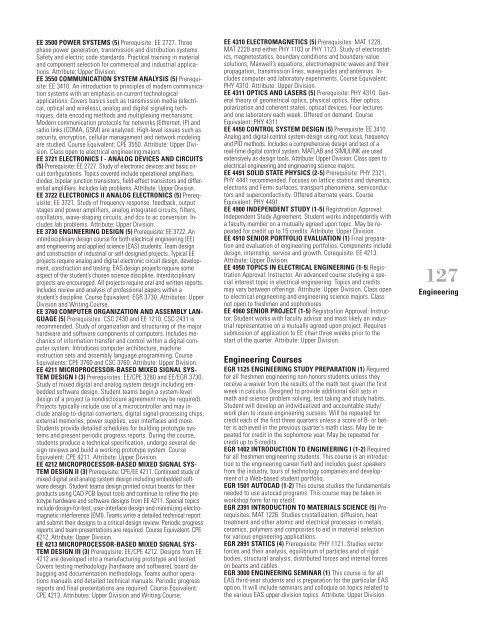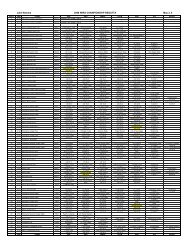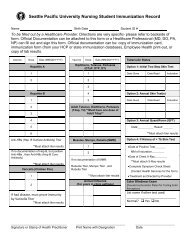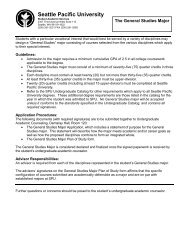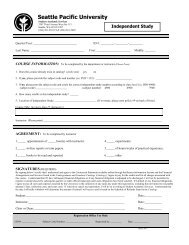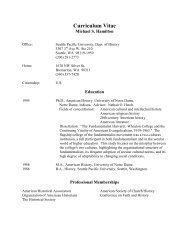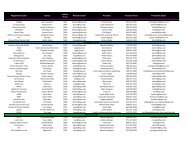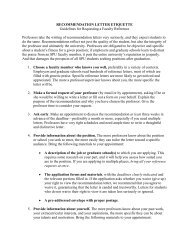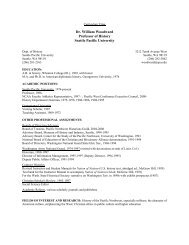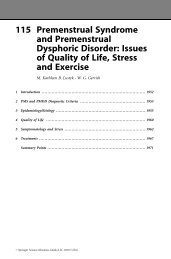Accounting Anthropology Art - Seattle Pacific University
Accounting Anthropology Art - Seattle Pacific University
Accounting Anthropology Art - Seattle Pacific University
You also want an ePaper? Increase the reach of your titles
YUMPU automatically turns print PDFs into web optimized ePapers that Google loves.
EE 3500 POWER SYSTEMS (5) Prerequisite: EE 2727. Three<br />
phase power generation, transmission and distribution systems.<br />
Safety and electric code standards. Practical training in material<br />
and component selection for commercial and industrial applications.<br />
Attribute: Upper Division.<br />
EE 3550 COMMUNICATION SYSTEM ANALYSIS (5) Prerequisite:<br />
EE 3410. An introduction to principles of modern communication<br />
systems with an emphasis on current technological<br />
applications. Covers basics such as transmission media (electrical,<br />
optical and wireless), analog and digital signaling techniques,<br />
data encoding methods and multiplexing mechanisms.<br />
Modern communication protocols for networks (Ethernet, IP) and<br />
radio links (CDMA, GSM) are analyzed. High-level issues such as<br />
security, encryption, cellular management and network modeling<br />
are studied. Course Equivalent: CPE 3550. Attribute: Upper Division.<br />
Class open to electrical engineering majors.<br />
EE 3721 ELECTRONICS I - ANALOG DEVICES AND CIRCUITS<br />
(5) Prerequisite: EE 2727. Study of electronic devices and basic circuit<br />
configurations. Topics covered include operational amplifiers,<br />
diodes, bipolar junction transistors, field-effect transistors and differential<br />
amplifiers. Includes lab problems. Attribute: Upper Division.<br />
EE 3722 ELECTRONICS II ANALOG ELECTRONICS (5) Prerequisite:<br />
EE 3721. Study of frequency response, feedback, output<br />
stages and power amplifiers, analog integrated circuits, filters,<br />
oscillators, wave-shaping circuits, and dcs to ac conversion. Includes<br />
lab problems. Attribute: Upper Division.<br />
EE 3730 ENGINEERING DESIGN (5) Prerequisite: EE 3722. An<br />
interdisciplinary design course for both electrical engineering (EE)<br />
and engineering and applied science (EAS) students. Team design<br />
and construction of industrial or self-designed projects. Typical EE<br />
projects require analog and digital electronic circuit design, development,<br />
construction and testing. EAS design projects require some<br />
aspect of the student’s chosen science discipline. Interdisciplinary<br />
projects are encouraged. All projects require oral and written reports.<br />
Includes review and analysis of professional papers within a<br />
student’s discipline. Course Equivalent: EGR 3730. Attributes: Upper<br />
Division and Writing Course.<br />
EE 3760 COMPUTER ORGANIZATION AND ASSEMBLY LAN-<br />
GUAGE (5) Prerequisites: CSC 2430 and EE 1210. CSC 2431 is<br />
recommended. Study of organization and structuring of the major<br />
hardware and software components of computers. Includes mechanics<br />
of information transfer and control within a digital computer<br />
system. Introduces computer architecture, machine<br />
instruction sets and assembly language programming. Course<br />
Equivalents: CPE 3760 and CSC 3760. Attribute: Upper Division.<br />
EE 4211 MICROPROCESSOR-BASED MIXED SIGNAL SYS-<br />
TEM DESIGN I (3) Prerequisites: EE/CPE 3280 and EE/EGR 3730.<br />
Study of mixed digital and analog system design including embedded<br />
software design. Student teams begin a system-level<br />
design of a project (a nondisclosure agreement may be required).<br />
Projects typically include use of a microcontroller and may include<br />
analog-to-digital converters, digital signal-processing chips,<br />
external memories, power supplies, user interfaces and more.<br />
Students provide detailed schedules for building prototype systems<br />
and present periodic progress reports. During the course,<br />
students produce a technical specification, undergo several design<br />
reviews and build a working prototype system. Course<br />
Equivalent: CPE 4211. Attribute: Upper Division.<br />
EE 4212 MICROPROCESSOR-BASED MIXED SIGNAL SYS-<br />
TEM DESIGN II (3) Prerequisite: CPE/EE 4211. Continued study of<br />
mixed digital and analog system design including embedded software<br />
design. Student teams design printed circuit boards for their<br />
products using CAD PCB layout tools and continue to refine the prototype<br />
hardware and software designs from EE 4211. Special topics<br />
include design-for-test, user-interface design and minimizing electromagnetic<br />
interference (EMI). Teams write a detailed technical report<br />
and submit their designs to a critical design review. Periodic progress<br />
reports and team presentations are required. Course Equivalent: CPE<br />
4212. Attribute: Upper Division.<br />
EE 4213 MICROPROCESSOR-BASED MIXED SIGNAL SYS-<br />
TEM DESIGN III (3) Prerequisite: EE/CPE 4212. Designs from EE<br />
4212 are developed into a manufacturing prototype and tested.<br />
Covers testing methodology (hardware and software), board debugging<br />
and documentation methodology. Teams author operations<br />
manuals and detailed technical manuals. Periodic progress<br />
reports and final presentations are required. Course Equivalent:<br />
CPE 4213. Attributes: Upper Division and Writing Course.<br />
EE 4310 ELECTROMAGNETICS (5) Prerequisites: MAT 1228,<br />
MAT 2228 and either PHY 1103 or PHY 1123. Study of electrostatics,<br />
magnetostatics, boundary conditions and boundary-value<br />
solutions, Maxwell’s equations, electromagnetic waves and their<br />
propagation, transmission lines, waveguides and antennas. Includes<br />
computer and laboratory experiments. Course Equivalent:<br />
PHY 4310. Attribute: Upper Division.<br />
EE 4311 OPTICS AND LASERS (5) Prerequisite: PHY 4310. General<br />
theory of geometrical optics, physical optics, fiber optics,<br />
polarization and coherent states, optical devices. Four lectures<br />
and one laboratory each week. Offered on demand. Course<br />
Equivalent: PHY 4311.<br />
EE 4450 CONTROL SYSTEM DESIGN (5) Prerequisite: EE 3410.<br />
Analog and digital-control system design using root locus, frequency<br />
and PID methods. Includes a comprehensive design and test of a<br />
real-time digital control system. MATLAB and SIMULINK are used<br />
extensively as design tools. Attribute: Upper Division. Class open to<br />
electrical engineering and engineering science majors.<br />
EE 4491 SOLID STATE PHYSICS (2-5) Prerequisite: PHY 2321;<br />
PHY 4441 recommended. Focuses on lattice statics and dynamics,<br />
electrons and Fermi surfaces, transport phenomena, semiconductors<br />
and superconductivity. Offered alternate years. Course<br />
Equivalent: PHY 4491.<br />
EE 4900 INDEPENDENT STUDY (1-5) Registration Approval:<br />
Independent Study Agreement. Student works independently with<br />
a faculty member on a mutually agreed upon topic. May be repeated<br />
for credit up to 15 credits. Attribute: Upper Division.<br />
EE 4910 SENIOR PORTFOLIO EVALUATION (1) Final preparation<br />
and evaluation of engineering portfolios. Components include<br />
design, internship, service and growth. Corequisite: EE 4213.<br />
Attribute: Upper Division.<br />
EE 4950 TOPICS IN ELECTRICAL ENGINEERING (1-5) Registration<br />
Approval: Instructor. An advanced course studying a special<br />
interest topic in electrical engineering. Topics and credits<br />
may vary between offerings. Attribute: Upper Division. Class open<br />
to electrical engineering and engineering science majors. Class<br />
not open to freshmen and sophomores.<br />
EE 4960 SENIOR PROJECT (1-5) Registration Approval: Instructor.<br />
Student works with faculty advisor and most likely an industrial<br />
representative on a mutually agreed upon project. Requires<br />
submission of application to EE chair three weeks prior to the<br />
start of the quarter. Attribute: Upper Division.<br />
Engineering Courses<br />
EGR 1125 ENGINEERING STUDY PREPARATION (1) Required<br />
for all freshmen engineering non-honors students unless they<br />
receive a waiver from the results of the math test given the first<br />
week in calculus. Designed to provide additional skill sets in<br />
math and science problem solving, test taking and study habits.<br />
Student will develop an individualized and accountable study/<br />
work plan to insure engineering success. Will be repeated for<br />
credit each of the first three quarters unless a score of B- or better<br />
is achieved in the previous quarter’s math class. May be repeated<br />
for credit in the sophomore year. May be repeated for<br />
credit up to 5 credits.<br />
EGR 1402 INTRODUCTION TO ENGINEERING I (1-2) Required<br />
for all freshmen engineering students. This course is an introduction<br />
to the engineering career field and includes guest speakers<br />
from the industry, tours of technology companies and development<br />
of a Web-based student portfolio.<br />
EGR 1501 AUTOCAD (1-2) This course studies the fundamentals<br />
needed to use autocad programs. This course may be taken in<br />
workshop form for no credit.<br />
EGR 2391 INTRODUCTION TO MATERIALS SCIENCE (5) Prerequisites:<br />
MAT 1226. Studies crystallization, diffusion, heat<br />
treatment and other atomic and electrical processes in metals,<br />
ceramics, polymers and composites to aid in material selection<br />
for various engineering applications.<br />
EGR 2891 STATICS (4) Prerequisite: PHY 1121. Studies vector<br />
forces and their analysis, equilibrium of particles and of rigid<br />
bodies, structural analysis, distributed forces and internal forces<br />
on beams and cables.<br />
EGR 3000 ENGINEERING SEMINAR (1) This course is for all<br />
EAS third-year students and is preparation for the particular EAS<br />
option. It will include seminars and colloquia on topics related to<br />
the various EAS upper-division topics. Attribute: Upper Division.<br />
127<br />
Engineering


